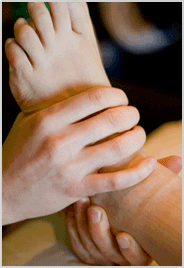Dr. McReynolds practices the full spectrum of traditional osteopathic manipulative medicine, tailoring the treatment plan to each individual and circumstance. Below are some of the manipulation procedures most commonly used by Dr. McReynolds, to diagnose and treat somatic dysfunctions:
Soft-Tissue Technique – This technique is commonly applied to the musculature surrounding the spine and consists of a rhythmic stretching, deep pressure and traction. Its purpose is to move tissue fluids and to relax hypertonic muscles and myofascial (fibrous tissue) layers associated with somatic dysfunction.
Cranial Osteopathy – Cranial osteopathy is a powerful, yet gentle form of osteopathic manipulation. This technique works by optimizing the position and function of the bones and membranes of the head. This very gentle form of manipulation is great for headaches, TMJ disorders and other head disorders. It is so gentle, and effective, that this approach has been found to be beneficial for treatment of infants and children.
Jones Counterstrain – This very gentle technique works with the muscles and connective tissues of the body. Tight, painful muscles are placed in a position where the muscle is allowed to relax and the pain generators disappear. This technique works very well for patients with arm and leg pain. Patients with headaches, low back pain, fibromyalgia and arthritis frequently see benefit with this technique as well.
Muscle Energy – Muscle energy uses the muscles of the body, to realign the bones. The patient is placed in very specific positions and then presses very gently against a counterforce supplied by the doctor. The patient is using his or her own muscle force to provide a gentle and effective realignment of their bones.
Myofascial Release – This technique releases the tissue that surrounds all of the body structures. This gentle technique is often applied after other osteopathic manipulation techniques to help eliminate the chronic pattern from the body. Myofascial release helps the effect of the treatment to last much longer.
Lymphatic Technique – This manual procedure is designed to promote circulation of the lymphatic fluids and can be used to relieve upper and lower respiratory infections. One technique is pressure applied with the physician’s hands to the prone patient’s upper anterior chest wall. When force applied to the chest reaches its maximum on expiration, the physician’s hands are removed suddenly. This increases negative pressure of the chest to assist the body’s respiratory mechanism to move lymphatic fluids.
Visceral Manipulation – Visceral manipulation is a gentle technique that focuses on the proper function of the internal organs. This technique involves gentle stretching and balancing of the tension forces that impact the function of the internal organs. This technique works well for infertility problems, abdominal pain, pelvic pain, urinary incontinence and many other health problems.
Percussion Hammer – The Fulford Percussion Hammer was invented by the late, Robert Fulford, D.O., to help treat the fascial "stuckness" in the body. He was an engineer and an osteopathic physician who determined that the use of the percussion hammer through a vibrational frequency is very effective in "unlocking" stuck fascia. It is a very effective treatment tool, and can be used in patients of all ages, including infants.
HVLA – HVLA stands for high velocity, low amplitude. This technique uses gentle force to mobilize the joints of the body. The mobilizing force is gentle, but frequently results in a popping sound that can be heard by the patient. This technique works well for conditions that are not chronic, long-standing problems. While this technique is highly effective for some conditions, some patients prefer other forms of osteopathic manipulation and we are always sensitive to these requests.
Balanced Ligamentous Tension (BLT)– BLT involves 3 main steps: disengagement, exaggeration, and balancing the tissues (fascia, ligaments and tendons). Indirectly, lymphatics and blood flow are increased, and tissue tenson is released.
Fascial Distortion Model (FDM)–The late Stephen, Typaldos, D.O., is the originator and developer of FDM. Treatment is directed into specific anatomical distortions of the capsule, ligaments, and surrounding fascia, physically reversing them. When fascial distortions are corrected, the injury ceases to exist.
Facilitated Positional Release (FPR)–Developed by the late Stanley Schiowitz, D.O., FPR is a system of indirect myofascial release treatment. A region of the body is placed into a neutral position, which decreases tissue and joint tension in all planes, and an activating force (compression or torsion) is added to facilitate release of the tissue tensions.
Articulatory – a low velocity/ moderate to high amplitude technique where a joint is carried through itsfull motion with the therapeutic goalof increased range of movement. The activating force is either a repetitive springing motion or repetitive concentric movement of the joint through the restrictive barrier.
